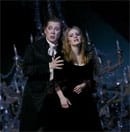Story of a love at first sight whose psychological and behavioral triggers have been wonderfully highlighted and commented on by the prelate-writer. A dual experience, also reflecting that of the author, torn between his civilian life and his religious calling. Manon decides to live this experience to the end, to her death, she who loves the pleasures of life so much. Perfect ambiguity. It is on this plot that the composer Jules Massenet wrote his most popular work, “Manon,” between 1882 and 1883, which premiered at the Opéra Comique on January 19, 1884. Despite its scandalous nature – the story is set in the eighteenth century – this tale of intense, thwarted, and tragic love affirmed the theme of uncontrolled exacerbation of feelings that so inspired the music of the romantic era. Manon Lescaut, a young woman from a good family, torn between ardent love for Chevalier Des Grieux and the allure of a frivolous world and libertine pleasures, discovers, experiences, understands, and finally accepts her fate: “I must die,” she says at the moment of her agony.
To rise to this challenge, the Nice Opera left nothing to chance. From the voices to the staging, from the costumes to the lighting, from the conducting to the choreography of the ballet, from the sets to the choirs of the Opera, not a single piece was missing for the success of this premiere. Before each of the six tableaux, an invisible white feather writes a few chosen lines from Abbé Prévost on the black curtain, a reminder of Massenet’s own stay in the writer’s room, to enrich his inspiration. Directed by Patrick Fournillier, musical director of the Massenet Festival in Saint Etienne, the composer’s birthplace and therefore a great expert on this work, the Nice Opera Orchestra significantly helped to provide the musical breath, capable of reinforcing the moments of dramatic intensity that guide the artists’ performances.
We must commend the particularly fortunate, balanced choice of these artists: each of the principal roles found its place and thus brought all its richness in connection with the character portrayed. Notably, the very beautiful performances by Lescaut, the heroine’s cousin, played by Jean-Luc Ballestra, an artist with a very beautiful, broad, and stable bass voice, rewarded as “lyric revelation of the year” at the 2007 music victories. Also, the Count Des Grieux, played by Marcel Vanaux, a particularly warm and magnificent bass in his despairing role as the father who vainly tries to bring his son to reason. Mention must also be made of the pleasure provided by the stage and vocal performance of the “girls” Poussette, Javotte, and Rosette, respectively Laure Baert, Caroline Fèvre, and Juliette Mars, sort of modern “Fates” who, through their attitudes and their comments, announce the unfolding of the drama.
In the title roles of Manon and Chevalier Des Grieux, soprano Nathalie Manfrino and American tenor Gregory Kunde complement each other advantageously. Manon’s character oscillates in the libretto by Meilhac and de Gille between the extremes of exaltation and collapse, exemplified in the first act, marked by painful hesitations between choosing a “life of pleasure” and “abandoning her fantasies.” In this regard, Nathalie Manfrino seems much more comfortable with the extremes, although sometimes bordering on a sound that is too technical, slightly artificial. Nonetheless, the soprano’s voice alternates with indescribable ease between beautiful soaring highs and more inward, restrained melodies: her “adieu notre petite table,” scenically debatable by its gestural neutrality, delivers to the audience the profound nature of her inner turmoil. In response, in correspondence with his unwavering loyalty to his feelings for Manon, the tenor prefers constancy, with a voice more marked by the occasional expression of power or pain than by the range of his lyrical register. Both vocally and necessarily within the story, the two heroes believe they are meeting but in fact only brush past each other, seeking each other out. This is evidenced by the melody “N’est-ce plus ma main que cette main presse?” sung by Manon to successfully reclaim the heart of a Chevalier who is about to confirm his entry into the orders. The same air sung at the very end of the last act by Des Grieux in an attempt to save Manon from her inevitable agony. In vain this time.
One cannot overlook what has greatly contributed to the exemplariness of this premiere: starting with the undeniable efforts in terms of sets by Emmanuelle Favre, notably the symbolism of the lit chandelier in the betting hall, a chandelier fallen to the ground in the decadent and morbid universe of the last act which recalls the giant chandelier in the Idoménée produced at the Hamburg Opera by Nicolas Brieger. Sets made on two levels allowing the exploitation of a particularly lively stage dynamic by Nadine Duffaut, Eighteenth-century costumes by Katia Duflot, from the most modest to the “elegant,” including the red of a bloody incandescence that dresses Manon and Des Grieux at the Hotel de Transylvania, extraordinary plays of lights and illuminations by Marc Delamezière, creating the warmest and most enveloping atmospheres as well as the chilliest environments. Finally, as in any “grand opera,” the presence of the ballets of the Opera of Nice with the remarkable work of the choreographer Eric Belaud, who inserted dance both as an interlude and as a pivotal moment of the unfolding drama: Manon decides to go to Saint Sulpice to find her Chevalier and snatch him from the clutches of religion. A “Manon” that remains nonetheless delicate, sensitive, ultimately moving by her maturity acquired on the threshold of death. In short, a “Manon” that will count among the successes of the Nice Opera.


